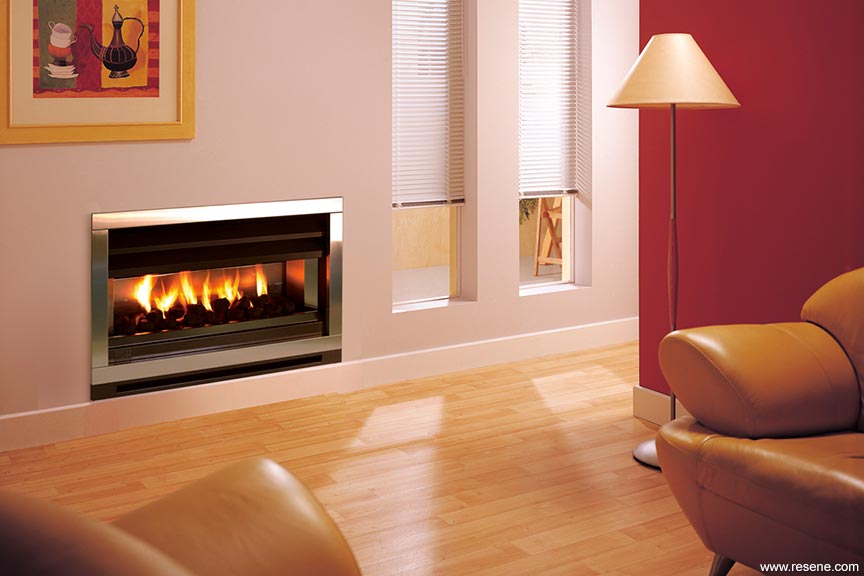From Habitat magazine - issue 06
Long before summer is over, it’s wise to start thinking how to cosy up your house for the cold, rainy days ahead.
However, before you start to switch on the heating, it pays to make sure your home is well insulated and isn’t damp. A dry, fully insulated home consumes about half the heat of one without insulation, according to the Energy Efficiency and Conservation Authority (EECA).

As up to 34% to 40% of heating is lost through the ceiling and a further third through floors, good insulation saves more than $400 a year in bills, according to the EECA. This is why, if you’re building, you should be sure to add insulation to concrete floors right up to the slab edges.
While it’s generally hard to add wall insulation to an existing home, take the opportunity to add it if you’re changing walls in a renovation. You can insulate windows with double-glazing, which is becoming more and more affordable. Prevent heat leak with thermal-lined curtains, adding generous margins on the sides and a pelmet at the top to trap the air and contain heat.
And dry out the damp: A humid house is hard to heat, because heat energy is absorbed by the moisture before the temperature can rise. A dehumidifier is a good start, but a forced ventilation system such as that offered by HRV, which replaces the moist air in the house with dry air from the ceiling, is a great first line in home heating.
The sun’s rays are cheap and – mostly – available, so use them well. Focus on design that uses passive solar heating: Windows oriented to the north or north west, and banks of insulation in floors, ceilings and walls to hold the heat captured during the day for release after dark.
For best comfort and cost savings, choose heat governed by smart electronic timers and thermostats. Electronic brains detect temperature changes before you do, boosting the heat for a short period to maintain comfort, and requiring less energy to do so than re-warming cold air. Set timers to warm bathrooms and living spaces an hour before you wake up in the morning and before you come home at night.
How can you figure out what works best for your house? The EECA recommends a heat pump, flued gas heater, or low-emission burner for a poorly insulated home. Better insulation makes central heating (heat pump or gas) more cost effective, while if your house is fully insulated, you may need only a flued gas heater, night-store or under-floor heating. In colder climates, consider a high-efficiency solid fuel, diesel or LPG-fuelled heater.
The luxury of central heating means no closing off rooms or retreating from cold spots. Thermostats keep the house toasty, and the dry air keeps humidity and mildew at bay. Gas or electric-powered, heating can be retrofitted under floor or in the ceiling. With heat pumps, running costs can sit at around 6c to 9c per KWh*.
Heat pumps are the hot news at the moment, as their efficiency now tops 300% – that’s three times the heat out for every unit of power in. Modern units are slim and quiet, with programmable timers, clean air filters and more. They are cheap to run, at 4.5c to 8c per KWh.
When you’re renting or need spot heating in a room, portable heaters still have their place. Watch out for safety – newer ceramic heaters switch off if they’re tipped and can’t ignite materials. However, running costs are around 17c per KWh.
Under tiles, under carpet and now even in do-it-yourself mats, underfloor heating keeps toes cosy and rooms dry. Running costs can be as little as 5c per hour for an average bathroom or 15c for a 10sqm room. Make sure you use a reputable installer, as most damage is a result of bad workmanship, not faulty cables. With free running costs (but allow a few dollars a month for the circulating pump), the higher installation costs of solar in-floor heating can be recovered over the life of your house. This way, water pipes sunk deep in a concrete slab keep the house at an even temperature, although slow build up means the heat is hard to regulate.
We all realise that fires are not as house warming as other forms of heat, as they convert only 85% of the energy consumed to warmth. And many local authorities now ban old-fashioned fires. Unless you have free fuel, running costs can top 85c per KW of energy.
When it comes to the best option for you, shop around for good advice from established and experienced home heating specialists, to calculate the right size and type of heat for your home and lifestyle. The EECA recommends, in particular, that you talk to members of the NZ Home Heating Association, who are trained to provide sound advice.
For more information, check www.energywise. govt.nz for tips and recommendations.
*Running costs provided by the EECA, estimating the cost of one unit of heat (KW) for each hour (h) of the major heating options. See www.eeca.govt.nz.
words: Kate Williams
pictures: Courtesy of Rinnai
Search habitat magazine stories
Printed copies of habitat highlights are available from late March 2024 at Resene ColorShops and resellers, while stocks last. You can view back issues of habitat magazine online.
Specifiers:
If you have an idea, project or story that you think would suit habitat, we’d love to hear from you. Please drop us an email with your details and include photos if submitting a project.
Sign up for a DIY card and Save! Australia | New Zealand